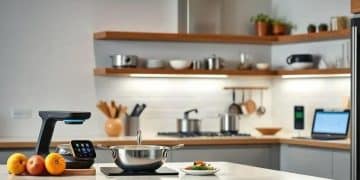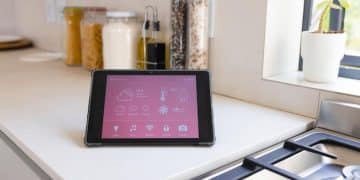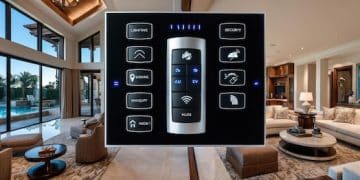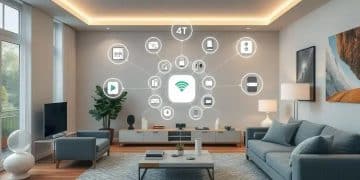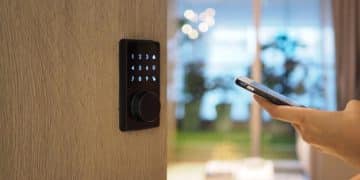Automate Kitchen Efficiency: Integrating Smart Appliances Guide
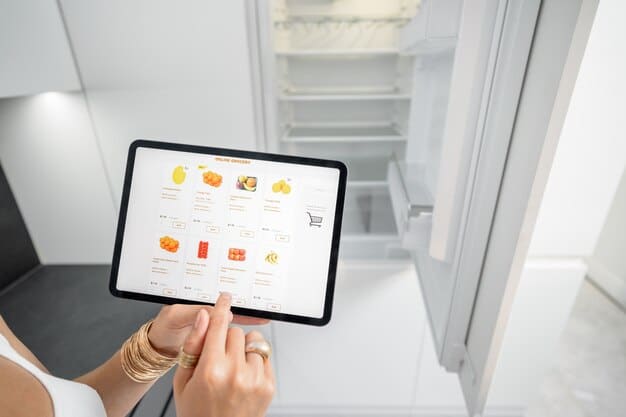
Integrating smart appliances automates your kitchen, enhancing efficiency by streamlining cooking, optimizing energy use, and providing convenient remote control, transforming daily routines into seamless experiences.
Ready to transform your kitchen into a hub of smart efficiency? Integrating smart appliances is the key to streamlining your cooking, saving energy, and enjoying unprecedented convenience.
Understanding Smart Appliances and Kitchen Automation
The concept of a smart kitchen has evolved from futuristic fantasy to a practical reality. Smart appliances are designed to make your life easier, more efficient, and even more enjoyable.
Kitchen automation, driven by these appliances, aims to streamline tasks, save time, and reduce energy consumption. But what exactly defines a smart appliance, and how does it contribute to overall kitchen automation?
What Defines a Smart Appliance?
Smart appliances are characterized by their ability to connect to a network, communicate with other devices, and offer features beyond traditional functionality. These features often include:
- Remote control via smartphone or tablet
- Voice command compatibility (e.g., Amazon Alexa, Google Assistant)
- Automated functions based on programmed schedules or user preferences
- Self-monitoring and diagnostic capabilities, alerting users to potential issues
The Benefits of Kitchen Automation
Automating your kitchen transcends mere convenience; it unlocks a realm of benefits that touch every facet of your culinary experience and home management. From saving precious time and energy to enhancing safety and enabling remote control, the advantages are compelling.
- Time-saving: Preheating your oven on the way home, or starting the dishwasher remotely.
- Energy efficiency: Smart refrigerators optimize cooling based on usage, smart ovens use only the necessary energy for cooking.
- Enhanced Safety: Smart stoves can automatically shut off if left unattended, preventing accidents.
- Remote control: Monitor and control appliances from anywhere, ensuring peace of mind.
In essence, understanding the core principles of smart appliances and kitchen automation lays the foundation for transforming your cooking space into a modern, efficient, and user-friendly environment.
Planning Your Smart Kitchen Integration
Before diving into the world of smart appliances, a solid plan is crucial. Consider your needs, budget, and the compatibility of devices within your home.
A well-thought-out strategy ensures a seamless integration process and maximizes the benefits of your automated kitchen.
Assessing Your Needs and Priorities
Start by identifying the areas in your kitchen where automation can make the biggest impact. Consider your cooking habits, family size, and lifestyle.
- What are your biggest pain points in the kitchen?
- Which appliances do you use most frequently?
- What features are most important to you (e.g., energy savings, convenience, safety)?
Budget Considerations
Smart appliances range in price, so setting a budget is essential. Factor in not only the cost of the appliances themselves, but also any installation or subscription fees.
Prioritize appliances that offer the best value for your money and align with your needs.
Compatibility and Ecosystem
Ensure that your chosen appliances are compatible with each other and with your existing smart home ecosystem (e.g., Amazon Alexa, Google Home, Apple HomeKit).
Choosing appliances from a single brand or ecosystem can simplify setup and control.

By carefully planning your smart kitchen integration, you can create a space that is not only technologically advanced but also perfectly tailored to your needs and lifestyle.
Key Smart Appliances for Kitchen Efficiency
Several smart appliances stand out for their ability to enhance kitchen efficiency and convenience. These devices offer a range of features that can streamline your cooking, save energy, and simplify your life.
Let’s explore some of the most impactful smart appliances for your kitchen:
Smart Refrigerators
Smart refrigerators go beyond basic cooling. They offer features such as:
- Built-in touchscreens for managing calendars, creating shopping lists, and displaying recipes
- Internal cameras that allow you to view the contents of your fridge remotely
- Connectivity to recipe apps and online grocery services
Smart Ovens and Cooktops
Smart ovens and cooktops provide precise temperature control, remote monitoring, and automated cooking programs. Key features include:
- Preheating from your smartphone
- Built-in cameras for monitoring cooking progress
- Automatic shut-off features for safety
Smart Dishwashers
Smart dishwashers optimize water and energy usage while providing convenient control. Notable features include:
- Remote start and monitoring
- Automatic detergent dispensing
- Leak detection and alerts
Smart Coffee Makers
Start your day right with a smart coffee maker that can be programmed to brew coffee automatically at a set time. Advanced models offer features like:
- Voice command activation
- Customizable brewing settings
- Automatic reordering of coffee beans
Investing in these key smart appliances can significantly improve your kitchen’s efficiency and convenience, making your daily cooking routines more enjoyable.
Setting Up Your Smart Appliances: A Step-by-Step Guide
Once you’ve selected your smart appliances, the next step is to set them up properly. The setup process typically involves connecting the appliances to your home network, downloading the corresponding apps, and configuring your preferences.
Here’s a step-by-step guide to help you get started:
Connecting to Your Home Network
Most smart appliances connect to your home network via Wi-Fi. Ensure that your network is stable and secure before proceeding.
- Refer to the appliance’s user manual for specific instructions.
- Typically, you’ll need to enter your Wi-Fi password via the appliance’s touchscreen or app.
- Some appliances may require a WPS (Wi-Fi Protected Setup) connection.
Downloading and Configuring the Apps
Each smart appliance usually has a corresponding app that allows you to control its features and settings. Download the app from your device’s app store (e.g., Apple App Store, Google Play Store).
- Create an account or log in using your existing credentials.
- Follow the app’s instructions to pair your appliance with your account.
- Configure your preferences, such as temperature settings, schedules, and notifications.
Integrating with Smart Home Ecosystems
To fully leverage the power of your smart appliances, integrate them with your smart home ecosystem. This allows you to control multiple devices from a single platform and create automated routines.
Most ecosystems, such as Amazon Alexa, Google Home, and Apple HomeKit, offer straightforward integration processes.
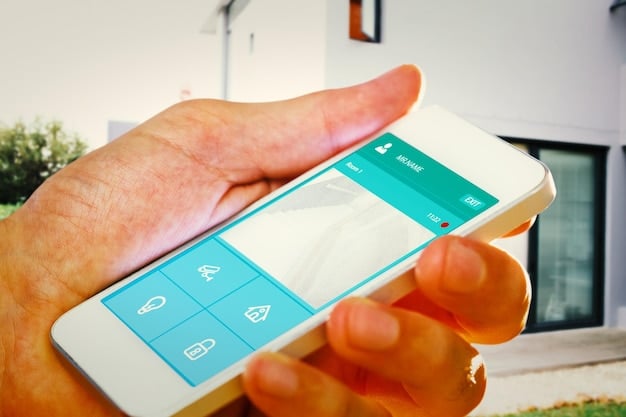
By following these setup steps, you can ensure that your smart appliances are properly connected and configured, ready to enhance your kitchen’s efficiency and convenience.
Optimizing Energy Efficiency with Smart Appliances
One of the key benefits of smart appliances is their ability to optimize energy efficiency. By using these devices intelligently, you can reduce your carbon footprint and lower your energy bills.
Here are some strategies for maximizing energy efficiency with your smart appliances:
Smart Refrigerators: Temperature Management
Smart refrigerators can automatically adjust their cooling based on usage patterns and ambient temperature. To maximize energy savings:
- Set the temperature to the optimal range (typically 37-40°F for the fridge and 0-5°F for the freezer).
- Avoid overfilling the refrigerator, as this can restrict airflow and reduce efficiency.
- Use the refrigerator’s energy-saving mode when possible.
Smart Ovens: Optimized Cooking
Smart ovens offer features such as convection cooking and preheating alerts that can save energy. To utilize them effectively:
- Use convection cooking for faster and more even cooking at lower temperatures.
- Preheat the oven only when necessary, and use the preheating alert feature to avoid wasting energy.
- Consider using a smaller appliance, such as a toaster oven or microwave, for smaller meals.
Smart Dishwashers: Efficient Washing
Smart dishwashers can optimize water and energy usage by adjusting the wash cycle based on the load size and soil level. Consider:
- Run the dishwasher only when it’s fully loaded.
- Use the eco-mode or energy-saving cycle when available.
- Avoid pre-rinsing dishes, as this wastes water.
By implementing these energy-saving strategies, you can significantly reduce your kitchen’s environmental impact and save money on your energy bills.
Troubleshooting Common Issues with Smart Appliances
Even with careful planning and setup, you may encounter issues with your smart appliances. These issues can range from connectivity problems to software glitches. Knowing how to troubleshoot common problems can save you time and frustration.
Here are some common issues and how to address them:
Connectivity Problems
If your smart appliance is unable to connect to your home network:
- Check your Wi-Fi router and ensure it’s working properly.
- Verify that the appliance is within range of the Wi-Fi signal.
- Restart the appliance and try connecting again.
- Update the appliance’s firmware to the latest version.
App Issues
If you’re experiencing problems with the appliance’s app:
- Ensure that you’re using the latest version of the app.
- Clear the app’s cache and data.
- Uninstall and reinstall the app.
- Contact the appliance manufacturer’s support team for assistance.
Software Glitches
If your appliance is experiencing software glitches, such as freezing or unexpected behavior:
- Restart the appliance.
- Perform a factory reset (refer to the user manual for instructions).
- Contact the appliance manufacturer’s support team for assistance.
By understanding these troubleshooting tips, you can resolve common issues and keep your smart appliances running smoothly.
| Key Point | Brief Description |
|---|---|
| 💡 Smart Refrigerator | Manages inventory, suggests recipes, and connects to shopping lists. |
| 🍳 Smart Oven | Offers remote control, precise temperature settings, and built-in cameras. |
| 💧 Smart Dishwasher | Optimizes water and energy use with remote start and leak detection. |
| ☕ Smart Coffee Maker | Automates brewing with voice commands and customizable settings. |
Frequently Asked Questions
▼
Integrating smart appliances enhances convenience, efficiency, and energy savings. You can control appliances remotely, automate tasks, and monitor energy usage, leading to a more streamlined and cost-effective kitchen.
▼
Choose appliances from the same ecosystem (e.g., Amazon Alexa, Google Home, Apple HomeKit) to ensure seamless integration. Check product specifications for compatibility with your existing smart home setup.
▼
Use strong, unique passwords for each appliance and your home Wi-Fi network. Enable two-factor authentication where available, and keep the firmware of your appliances updated to patch any security vulnerabilities.
▼
Smart appliances optimize energy usage through features like automatic temperature adjustments, energy-saving modes, and usage monitoring. This allows you to track and reduce your energy consumption, leading to lower utility bills.
▼
Check your Wi-Fi connection, ensure the appliance is within range, restart the appliance, and update the firmware. If problems persist, consult the manufacturer’s support for specific troubleshooting steps.
Conclusion
Integrating smart appliances into your kitchen is a game-changer for efficiency, convenience, and overall quality of life. By carefully planning, selecting the right appliances, and optimizing their settings, you can transform your kitchen into a smart, energy-efficient hub that simplifies your daily routines.
